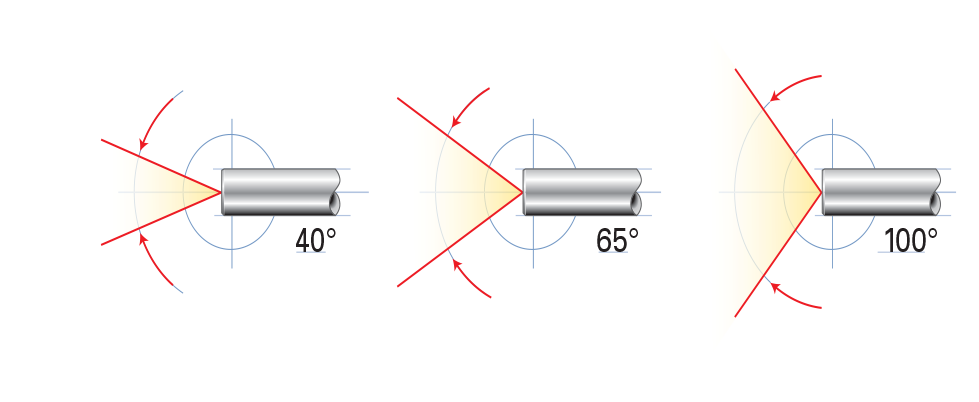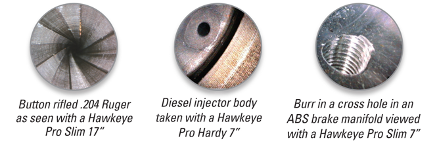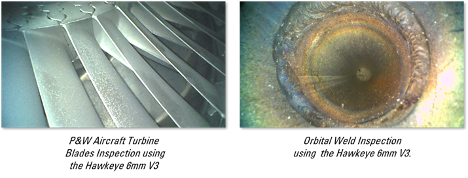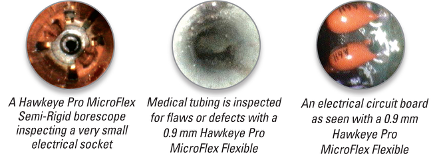Choose a Borescope
Rigid Borescopes
The heart of a rigid borescope design is the relay lens system. Gradient Lens Corporation’s patented endoGRINs® design makes lens manufacturing and assembly easier and less costly, without sacrificing image quality.

Our patented endoGRINs® gradient index lenses are the core technology of Hawkeye® Pro and Classic Rigid Borescopes. The elegant simplicity of the endoGRINs design gives excellent optical quality at a much lower cost than traditional alternatives, like the Hopkins design, which uses many expensive micro-lenses and optical glass rods. As described above, rigid borescopes use traditional, glass optics to relay the image. If your entry path is straight, a rigid borescope delivers excellent image quality and can be more cost-efficient than other types of borescopes, such as fiberoptic or video borescopes.
Video Borescopes
When compared with any other type of borescope, video borescopes deliver the best combination of image quality and convenience. Videoscopes transmit light through the objective lens to miniature video cameras, which then convey the image to a integrated handheld monitor or laptop and desktop computers. When portability, still and video image capture, and image storage and documentation are key factors, a videoscope is the right choice.

Rigid Borescope Direction-of-View (DOV)
Hawkeye Pro and Classic Rigid Borescopes see straight-ahead (0°) and sideways (90°) with a mirror tube that slides over the borescope tube, making them two borescopes in one. The Hawkeye Pro Slim Rigid also offers a special dedicated 30° or 70 Direction of View scope using a prism.

The mirror tube rotates the view over a full 360°, using the knurled knob. Our new mirrors are robust and durable for easy cleaning.
Video Borescope Direction-of-View (DOV)

Hawkeye Video Borescopes are offered in straight-ahead (0°) and sideways (90°) and dual view options with straight and side view (0° and 90°) cameras.
Field-of-View (FOV)

Most inspection situations need a “normal” objective lens (like a typical camera) with an angle of about 40°.
Hawkeye® Rigid Borescopes:
Choose a Hawkeye® Rigid Borescope when the entry path is straight. Compared to other types of borescopes, Rigids have better image quality and are more durable and less expensive than flexible scopes. Hawkeye® Pro Rigid Borescopes have DOV’s of 0°, 30°, and 90°.

Hawkeye® Micro Q2 Video Borescopes:
Inspecting small parts no longer means compromising on image quality. The Micro Q2 Video Borescope features an advanced high-resolution micro CMOS image sensor in as small as 0.95mm in diameter, delivering exceptional clarity. Effortlessly capture crisp, detailed images and save them directly to the onboard SD card or transfer them to your computer for easy analysis. Experience precision inspection like never before.

Hawkeye® Q2 Video Borescopes:
The Hawkeye Q2 HD Video Borescope offers a seamless transition from our V2 model, delivering six times the resolution in a more compact and portable design. Available in 2.8mm, 3.9mm, and 6mm diameters with lengths up to 7.5 meters, the Q2 is designed for versatility and high performance. Featuring 4-way joystick articulation, an HD camera for capturing high-resolution images and video, and interchangeable insertion tubes, the Q2 adapts to a variety of inspection needs.

Hawkeye® V3 Video Borescopes:
The Hawkeye® V3 HD Video Borescopes represent our next generation of fully portable, articulating, videoscopes. The innovative custom engineered image processor allows users to view or capture bright, crisp, clear images with lifelike colors. The servo driven articulation allows users to easily navigate even the toughest to access inspections.

Hawkeye® Q2 Dual View Video Borescopes:
The Q2 HD Dual View Video Borescope eliminates the need for thread-on tips, providing a streamlined solution for efficient inspections. Equipped with two integrated cameras, it allows users to effortlessly switch between straight-ahead and side-view perspectives at the touch of a button. Available in 2.8mm, 4.5mm, and 6mm diameters with lengths up to 7.5 meters, the Dual View Q2 is designed for versatility and precision. It features 4-way joystick articulation for enhanced maneuverability, a 4-hour integrated battery for extended operation, and interchangeable insertion tubes to adapt to various inspection needs. The HD cameras deliver high-resolution images and videos, which can be easily saved onto a micro-SD card for documentation and review.

Hawkeye® Micro Flex & Semi-Rigid Borescopes:
Hawkeye® Pro MicroFlex Semi-Rigid and Flexible Borescopes offer diameters as small as 0.5 mm, and a 10,000 or 30,000 fiber image bundle, all in “bendable,” semi-rigid, Nitinol or polymide sheath.
